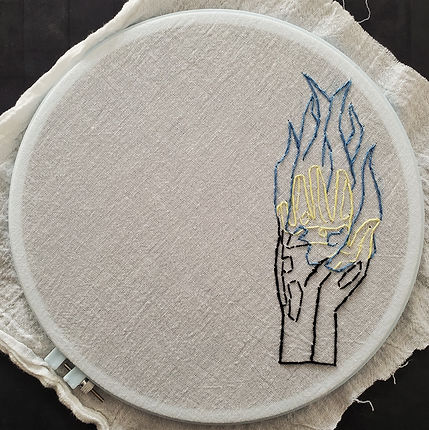Julius Yax

Art Journal 6:
Practice
3/25/2023
I officially ran out of room in my last embroidery piece and have started a brand new one! Its very exciting and there is nothing better to start it off with than a visual symbol of the power of asking questions and being open.


This journal is going to be focused on teaching Polaris students and the experience of teaching something that I know and love. I would have read the feedback from the students if it was provided but I have enough to talk about from my personal experience over the two classes and peer demo.
I am very grateful for the peer demo, we were able to fix some things that might have caused problems with the Polaris students, for example, we scaled down the size of the embroidery hoops available for the students because our peers were only able to fill up about 20% of it in half the time the students would have. We also pre-measured some yarn and wrapped it separately in case multiple students wanted to punch needle with the same color at the same time. During the peer lesson, Ashley and I were able to hash out the demos a little bit too. Mostly just figured out what was going to happen when we actually teach it. We made the decision to assume no one had any experience in embroidery or punch needling so we planned to do a full and detailed demo.
The first Polaris day was very nerve-wracking. Our group consisted of just high schoolers and I have thus far had no experience in a high school art classroom so I was not sure exactly what to expect other than being told that they’re good and respectful students. They talked a lot less than I had assumed and hoped they would. I think they were all Seniors and they knew each other pretty well it seems so they talked amongst themselves a little bit but, again, not a ton. Another thing is that they didn’t ask questions. Even if I could tell they were struggling and asked if they needed help with anything, they assured me they were just fine. They said they all had experience with embroidery so I skipped that demo but I wish I would have done some of it because one of the students seemed like they may not have had any experience and just agreed with the majority. For everyone, the punch needling was new, as expected so I went through and did the demonstration. I learned a lot from that first group as far as what makes sense and what doesn’t in my instructions, Ashley helped a lot too in remembering some of the basics I forgot to mention and working through problems as they arose. The plan for them was to create some sort of landscape. None of them finished in the two-hour class period and even though we gave them options for different ways they could finish at home, we were all a bit disappointed.
The second Polaris day was by far my favorite. We got rid of the landscape requirement as well as the expectation that they fill the whole space in two hours. Because we got rid of the landscape requirement, the embroidery and punch needle demo were now evenly split between us so it went much smoother. We had middle schoolers that day and they were all unfamiliar with both media so it was exciting to see how easily they pick up on it and their willingness to ask questions and explore was so inspiring. They asked questions about and tried things that I haven’t even thought of and I have been working with both these media for over a year now.
This experience was the first time I had ever really considered teaching in a middle school classroom. I think it's hard to really see what middle school is like during practicum because you enter another teacher’s classroom instead of a “fresh” class and you act as a guest (and helper, if they trust you) within the space that has already been created. I saw the difference in the energy between middle school and high school and the difference in willingness to make mistakes and try new things. Not to say that all middle schoolers or high schoolers are the exact same as these six students I came in contact with but as I get further into practicum I begin to see more of the differences between the grades groups. It's very interesting.
I don’t have a printed theory or pedagogy to relate to this that I haven’t already talked about. More like some advice that has been given to me repeatedly by professors and mentor teachers alike. It's that I simply won’t have it together my first year, or first few years of teaching. That some lessons need to go through a few iterations before they’re good, and some will be taught only once and need to be left in the dust. It was very short but I felt that practice-makes-perfect effect during Polaris.